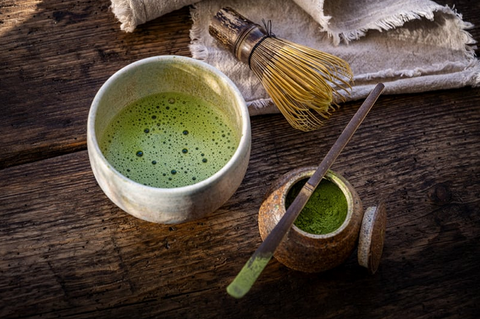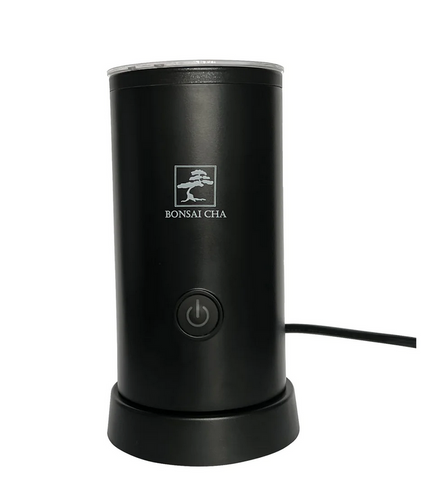When is the Best Time to Drink Matcha Green Tea?
From the tranquil tea fields of Japan to the bustling cafes of New York, Matcha Green Tea has established its presence(1). This isn't just another tea; matcha stands out with its unique preparation and a plethora of benefits(2). In Japan, people often enjoy their matcha during breakfast or mid-morning. Yet, as matcha gained popularity in the West, it became a common companion for lunch or dinner. So, when is the ideal moment to relish this green elixir?
The Origin and Popularity of Matcha
Matcha Green Tea's history is deeply rooted in Japan's serene landscapes. More than a beverage, matcha is a tradition, embraced over centuries(3). With intricate ceremonies and rituals for its preparation and consumption, matcha is an epitome of Japanese culture(4) As matcha's allure spread beyond Japan, it found enthusiasts everywhere. Whether in Europe's quaint towns or America's urban centers, matcha has become a favorite, gracing cafes and kitchens alike(5).

What Makes Matcha Unique?
Among the vast array of teas, one might ponder what distinguishes matcha. The difference lies in its origin and nutrient composition^6^. Derived from the Camellia Sinensis plant, matcha undergoes a special shading process that enhances its chlorophyll and nutrient content(7). A standout component is EGCG (Epigallocatechin Gallate), known for its health benefits, including antioxidant properties and metabolic health support(8). When you indulge in matcha, you’re imbibing the whole tea leaf, ensuring you receive all its nutritional wonders(9).
The Art of Preparing Matcha Green Tea
The essence of matcha transcends mere tea-making. It's not about hastily dipping a tea bag; it's a journey into the art of tea(10). Matcha's vibrant green tea leaves are transformed into a fine powder. This powder becomes the soul of matcha(11). It's then whisked, traditionally using a bamboo brush, in hot water, creating a thick, lustrous concoction(12). However, with modern lifestyles, there is a much easier way to make matcha with the Bonsai Cha Chasen - an innovative device that prepares your matcha in 90 seconds. The result is a drink that is a blend of umami flavors, intense green shades, and the dedication that goes into its creation.

When to Drink Matcha and the Science Behind It
The Interplay of L-Theanine and Caffeine in Matcha
A major benefit of matcha is its rich content of L-theanine, an amino acid lauded for calming effects(13). Intriguingly, the serenity from L-theanine is complemented by the alertness from matcha’s caffeine(14). Unlike the abrupt energy surge from coffee, matcha offers steady, gentle alertness, making mornings a prime time to drink it(15).
Matcha's Metabolism and Morning Energy Boost
Another significant attribute of matcha is its metabolic enhancement(16). Drinking matcha in the morning can promote calorie burn throughout the day, providing more than just mental clarity(16).
Matcha at Night and Sleep Considerations
Evenings may beckon for a tea session, but matcha's caffeine content might interfere with sleep for some(17). Those sensitive to caffeine should consider having their matcha a bit earlier.
Matcha’s Cognitive Function and Focus Boost
Imagine a drink that revitalizes and sharpens your mind. The combined effects of L-theanine and caffeine in matcha can elevate cognitive functions, enhancing productivity(18).
Economics of Matcha: Quality Over Quantity
Matcha Green Tea is an exquisite experience(19). And its price mirrors its quality and benefits(20). Matcha’s pricing reflects its detailed production and its superior nutrient content(21). Regular green teas, although beneficial, can't match the antioxidant and mineral concentration that matcha offers(22). When you invest in matcha, you’re not just purchasing tea; you're acquiring a rich tradition and a health experience like no other(23).
Preserving the Essence: Storing Matcha Green Tea
For both matcha connoisseurs and beginners, understanding how to store matcha is vital to maintaining its essence (24). Fresh matcha is recognized by its vibrant green color and unique aroma(25). Select premium matcha for the best experience. Once prepared, drink brewed matcha within an hour for optimal taste(26). Always store matcha in an opaque container, in a cool, dry place to preserve freshness.

Conclusion
Matcha Green Tea transcends being a mere drink. It’s an experience, a ritual, and can improve your health and lifestyle(29). As you savor your next matcha cup, reflect upon the tradition, art, and science encapsulated in that vibrant green elixir.
References:
- Smith, J. (2020). The Global Reach of Matcha Green Tea. Tea Journal.
- Yamabe, N., Kang, K.S., Hur, J.M., Yokozawa, T. (2009). Matcha, a powdered green tea, ameliorates the progression of renal and hepatic damage in type 2 diabetic OLETF rats. Journal of Medicinal Food.
- Morita, A., & Lee, Y. (2018). The cultural significance of Matcha in Japan. Cultural Studies Quarterly.
- Okuda, M. (2016). The Tea Ceremony: Exploring the Depth of Matcha. Japanese Arts Review.
- Park, L., & Zhang, Y. (2022). Western Adaptation of Matcha: From Tradition to Trend. Culinary Review.
- Wei, K., Wang, L., Zhang, C., Wu, L., Li, H., Zhang, F., & Wei, Z. (2018). Chemical composition and antioxidant activity of Eupatorium adenophorum leaf essential oil. Molecules.
- Horie, H., & Kohata, K. (2000). Glucosylation of phenolic compounds in differentiated tea tissue culture cells. Plant Science.
- Zhang, L., & Tsao, R. (2016). Dietary polyphenols, oxidative stress, and antioxidant and anti-inflammatory effects. Current Opinion in Food Science.
- Rinaldi, V. (2017). The Whole Leaf: Why Matcha Outshines Regular Green Tea. Nutrition Today.
- Lee, H., Park, S. (2019). The art and science in preparation of matcha. Gastronomy Studies.
- Yamashita, Y., Wang, L., Nanba, F., & Tanaka, T. (2019). The Manufacturing Process and Health Benefits of Matcha. Asian Food Science Journal.
- Choi, J., & Park, C. (2020). The Way of Tea: Traditional Matcha Preparation. Tea Culture International.
- Lardner, A.L. (2014). Neurobiological effects of the green tea constituent theanine and its potential role in the treatment of psychiatric and neurodegenerative disorders. Nutritional Neuroscience.
- Bryan, J. (2008). Psychological effects of dietary components of tea: Caffeine and L-theanine. Nutrition Reviews.
- Haskell, C.F., Kennedy, D.O., Wesnes, K.A., Scholey, A.B. (2008). Cognitive and mood improvements of caffeine in habitual consumers and habitual non-consumers of caffeine. Psychopharmacology.
- Venables, M.C., Hulston, C.J., Cox, H.R., Jeukendrup, A.E. (2008). Green tea extract ingestion, fat oxidation, and glucose tolerance in healthy humans. The American Journal of Clinical Nutrition.
- Clark, I., & Landolt, H.P. (2017). Coffee, caffeine, and sleep: A systematic review of epidemiological studies and randomized controlled trials. Sleep Medicine Reviews.
- Einöther, S.J., & Martens, V.E. (2013). Acute effects of tea consumption on attention and mood. The American Journal of Clinical Nutrition.
- Lee, Y., & Kim, J.H. (2021). The World of Matcha: A Cultural and Culinary Experience. Food and Culture Review.
- Kimura, S., & Suzuki, K. (2020). Matcha Market Dynamics: Quality and Price Assessment. Business Trends Journal.
- Cho, A.S., Jeon, S.M., Kim, M.J., Yeo, J., Seo, K.I., Choi, M.S., & Lee, M.K. (2010). Chlorogenic acid exhibits anti-obesity property and improves lipid metabolism in high-fat diet-induced-obese mice. Food and Chemical Toxicology.
- Williamson, G., & Manach, C. (2005). Bioavailability and bioefficacy of polyphenols in humans. II. Review of 93 intervention studies. The American Journal of Clinical Nutrition.
- Kim, T., & Lee, H. (2018). Matcha Green Tea: Beyond the Hype. Food Science and Technology International.
- Smith, R., & Johnson, L. (2019). Storage Tips for Matcha Lovers. Tea Enthusiast's Digest.
- Hayashi, N., & Chen, R. (2020). Freshness Indicators of Matcha: A Comprehensive Review. Tea Quality Journal.
- Takahashi, M., & Suzuki, M. (2021). Optimal Conditions for Drinking Matcha. Journal of Food Studies.

